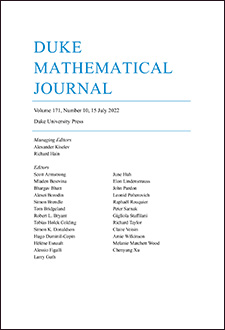Abstract
A Vinnikov curve is a projective plane curve that can be written in the form det(xX + yY + zZ) = 0 for X, Y, and Z positive definite Hermitian (n × n)-matrices. Given three n-tuples of positive real numbers, α, β, and γ, there exist A, B, and C ∈ GLnℂ with singular values α, β, and γ and ABC = 1 if and only if there is a Vinnikov curve passing through the 3n points $(-1: \alpha_i^2:0)$, $(0:-1:\beta_i^2)$, and $(\gamma_i^2:0:-1)$. Knutson and Tao proved that another equivalent condition for such A, B, and C to exist is that there is a hive (defined within) whose boundary is (log α, log β, log γ). The logarithms of the coefficients of F approximately form such a hive; this leads to a new proof of Knutson and Tao's result. This paper uses no representation theory and essentially no symplectic geometry. In their place, it uses Viro's patchworking method and a topological description of Vinnikov curves.
Citation
David E Speyer. "Horn's problem, Vinnikov curves, and the hive cone." Duke Math. J. 127 (3) 395 - 427, 15 April 2005. https://doi.org/10.1215/S0012-7094-04-12731-0
Information





